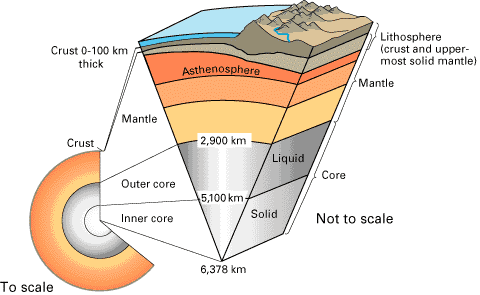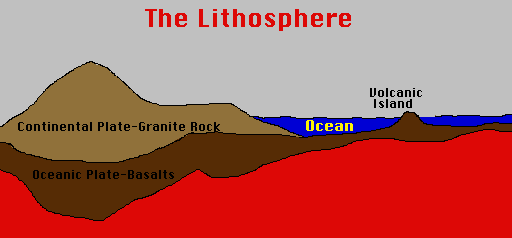The Layers of the Earth
The layers of the earth according to their physical properties:
|
1. Lithosphere 2. Asthenosphere 3. Mantle 4. Outer Core 5. Inner Core |
 |
The Physical Properties of Layers
 |
The
lithosphere
includes
the crust and the uppermost part of the mantle.
The cool, solid lithosphere floats on top of the asthenosphere. |
The
Asthenosphere
Scientists believe
that below the lithosphere is a relatively narrow, mobile zone in the mantle
called the asthenosphere (from asthenes, Greek for weak). This zone
is composed of hot, semi-solid material, which can soften and flow after
being subjected to high temperature and pressure over geologic time. The
rigid lithosphere is thought to "float" or move about on the slowly flowing
asthenosphere.
The
Mantle
This
layer is solid and rigid compared to the asthenosphere because the temperature
is not high enough to overcome the high pressure.
The
Outer Core
The
outer core is liquid. The circulation of its molten iron is thought
to be the source of earth's magnetic field.
The
Inner Core
There
is very high pressure in the inner core. As a result, even though
the temperature is extremely high, the inner core is solid.
Answer the following questions.
Everyone in your group should hand
in their own answers - in complete
sentences which restate the question.
1. Based on their characteristic
physical properties, what are the five
zones (layers)
of the earth?
2. What does the lithosphere include?
3. What is the hot, soft, and flowing condition of the asthenosphere called?
4. What is the physical condition of the outer core?
5. Why?
6. What is the physical condition of the inner core?
7. Why?
8. Consider the balance between temperature
and pressure within the earth.
How does depth affect
temperature and pressure?
| back
to
chemical layers |
More info on layers |